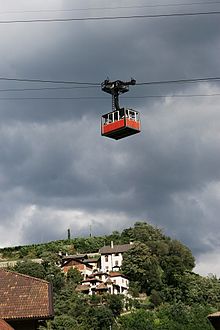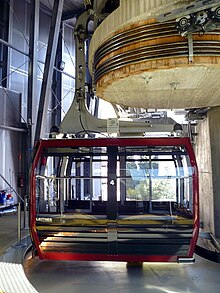Renon cable car
| Renon cable car | |
|---|---|
| Location: |
Bolzano , Italy |
| Mountains: | Alps |
| Overall length: | 4560 m |
| Height difference: | 950 m |
| Cable car type: | 3S train |
| Manufacturer: | Leitner |
| Valley station: | 46 ° 30 ′ 0 " N , 11 ° 21 ′ 51.1" E |
| Mountain station: | 46 ° 31 '40.3 " N , 11 ° 24' 18.3" E |
| journey | |
| Duration : | 11 to 12 minutes |
| Speed : | 25.2 km / h (7 m / s) |
| Transport performance : | 720 people / h |
| background | |
| Operator: | SAD local transport |
| Opening: | May 23, 2009 |
 route |
|
The Renon cable car is a cable car that runs from the South Tyrolean capital Bozen to Oberbozen on the Renon . The original aerial tramway was replaced by a 3S cableway in 2007 . It is part of the South Tyrol transport association .
Replacement for the Rittner Bahn
The Rittner cable car was actually supposed to replace the narrow-gauge Ritten railway because the investments for the maintenance of its cogwheel section were not or could not be raised. A serious accident on the railway line also accelerated the construction of the cable car. So the Renon Railway was closed, but after complaints from citizens of the city of Bolzano, the adhesion route over the Renon high plateau was retained.
Old Rittner cable car
Basic data of the aerial tramway
The aerial tramway , built by Ceretti e Tanfani and opened on July 14, 1966, was one of the longest passenger ropeways in the world with a length of 4,565 meters. With a travel time of 12 minutes and a speed of 8 m / s (28.8 km / h), the train overcame an altitude difference of around 950 meters. The cabins, which had a capacity of 50 people, floated from the Bozen valley station ( 276 m slm ) up to 1227 m slm to the Oberbozen mountain station. Because of the length of the route, only 250 people per hour could be conveyed. The cable car had a total of eight supports. It was overhauled by Agudio in 1986 .
Technical details
The cable car ran on a suspension cable with a diameter of 52 mm and was moved by a pull cable with a diameter of 27 mm. The counter rope (ballast rope) had a diameter of 22 mm. In addition, the railway had a 5 mm auxiliary rope. However, the long track length did not allow the carrying ropes to be tensioned in one piece. Therefore, the route was divided into two sections and the support 8 was erected as a supporting cable guy pillar to which the supporting cables from the mountain and valley sides were firmly anchored on large rollers. The two ropes on the mountain side were tensioned with weights of 70 t each, the valley side with weights of 60 t. The gondolas were pulled on the support 8 by the continuous pulling rope over a metal construction to the respective other supporting rope section.
Demolition of the old cable car
The cable car was closed in September 2007 and demolished until March 2008 because it was replaced by a gondola orbit.
New Rittner cable car
Basic data of the orbit
The new Rittner cable car opened on May 23, 2009. In contrast to the old aerial tramway, it is a 3S cable car with two suspension ropes and one pull rope that moves several cabins. Each cabin has a capacity of 35 seats (24 seats and 11 standing). A cabin leaves the station about every four minutes and reaches the Renon plateau in twelve minutes. Initially, the new Rittner cable car had eight cabins that could transport around 550 people per hour and thus significantly more passengers than the old cable car in each direction. Due to the strong demand, the number was increased by two additional cabins from eight to ten in the spring of 2015, increasing the transport capacity to 720 people per hour. Due to the 2020 corona pandemic , the capacity has been reduced to 15 people per cabin. This reduces the hourly transport capacity to 310 people per hour.
Technical details
The three-cable gondola built by Leitner has two suspension ropes with a diameter of 47 mm and a continuous, endlessly spliced traction rope of 40 mm on each lane . The cable car now only needs seven supports. The longest span between the supports is 958 m. In the stations, the cabins are moved onto a hanging rail, uncoupled from the pulling rope and stopped for getting on and off. Then they are accelerated again on the hanging rail, moved in the opposite direction onto the suspension ropes and coupled to the pull rope. When there is little traffic, fewer cars can be brought into circulation at greater intervals. The new 3S gondola travels at only 7 m / s (25.2 km / h), but has a higher transport capacity due to the continuously rotating gondolas and easier entry and exit.
workload
Thanks to commuters and tourists, the Renon cable car has a high occupancy rate. In 2016, around 1,041,939 passengers were counted. On the weekends in the tourist season, an average of between 3500 and 4500 cancellations are recorded.
Owner and operator
The Rittner cable car is owned by the South Tyrolean Transport Structures (STA) and operated by SAD Nahverkehr .
See also
Web links
- Ritten cable car on the website of the Ritten tourist office
- Press release on the opening
- Description and photo documentation of the new cable car on Remontées Mécaniques (French)
Individual evidence
- ↑ Ritten.org: The Rittner cable car
- ↑ Gondolas for Renon cable car are manufactured: red and glazed. Press service of the Autonomous Province of Bolzano - South Tyrol, August 26, 2008, accessed on May 23, 2014 .
- ↑ Rittner cable car will run again from tomorrow - two more cabins from spring. Press service of the Autonomous Province of Bolzano - South Tyrol, November 19, 2014, accessed on August 23, 2016 .
- ↑ Five years of the Rittner cable car: Almost 900,000 passengers in 2013 alone. Press service of the Autonomous Province of Bolzano - South Tyrol, May 22, 2014, archived from the original on May 24, 2014 ; accessed on May 23, 2014 . | Archived copy ( Memento from February 22, 2017 in the Internet Archive )
Coordinates: 46 ° 30 ′ 0 ″ N , 11 ° 21 ′ 51.3 ″ E









